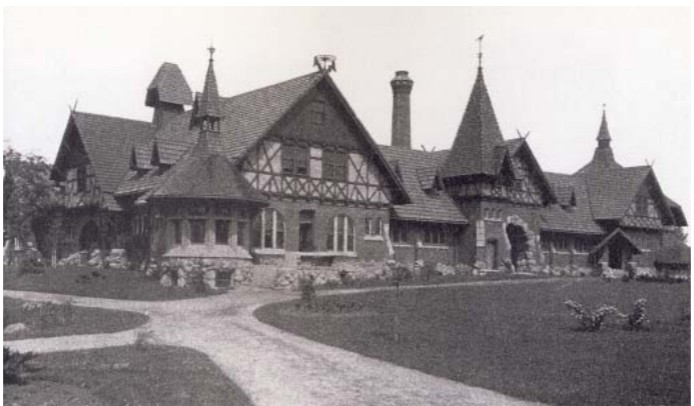National Museum of Puerto Rican Arts & Culture
Introduction
Text-to-speech Audio
Images

A picture of the stables in 1900.

Backstory and Context
Text-to-speech Audio
The National Museum of Puerto Rican Art and Culture is the only museum in the nation dedicated to showing Puerto Rican Art and cultures through out the year. Residing in the Renovated Humboldt Park Stables and Receptory at 3015 West Division Street, the museum was founded by Puerto Rican community members in Chicago in 2000 and was added as the latest museum in the park in February of 2012. The building itself as Queen Anne architectural features designed by Fromman and Jebson during 1895-1896. During this time, Danish immigrant Jens Jenson was named superintendent of the park. Currently, the museum is run by president Billy Ocasio.
In the 1940s, there was a significant
wave of Puerto Rican migration in Chicago. Puerto Ricans scattered in multiple
neighborhoods such as Lakeview and Lincoln Park then by the 1960s moved to Humboldt
Park and West Town due to urban renewal programs. As a result, Humboldt became
the official barrio of Chicago. According
to Billy Ocasio, the president of the museum, he thought Humboldt was a perfect
place to hold the museum because it was the center of Puerto Rican culture in
Chicago and as a result, the Stables were used to be the heart and shrine of
Puerto Rican culture.
A
social group called Los Caballeros de San
Juan was involved in promoting the integration of Puerto Rican migrants into
Chicago life. They created the event called the El Dia de San Juan which was later named the famous Puerto Rican
Parade. On the first Puerto Rican parade, however, there was a police shooting
of a young Puerto Rican man
that leads to a riot that also drew flame from police brutality and from unfair
living conditions and aid such as education, housing, health, and employment. Division
Street, the area that held the parade became known as Paseo Boricua which is known for the two Puerto Rican Flags and Puerto
Rican shops and restaurants.
The building in itself was created to display Humboldt Park as a “pastoral” park. The first function was to be the office of the then superintendent Jens Jenson. The park was constructed during a time where Chicagoans were trying to maintain public parks and create neighborhoods around the parks. By doing so, the city was able to make more profits from these high paying neighborhoods. The parks were a symbol of natural beauty that was famous for their recreational paths and horseback. The 206-acre Humboldt Park was meant to be a place to honor Baron Alexander von Humboldt who was a German naturalist and as an acknowledgment to the surrounding German community. As the lone standing building in Humboldt, the stables were left vacant for a number of years during the mid-1900’s. It wasn’t until 1990 where the Chicago Park District made plans to restore the historic site which was finished in 1997. The Puerto Rican Museum then inhabited in the stables and opened in 2007.
Today, the National Museum of Puerto Rican Art and Culture hosts a variety of workshops and exhibits that teach kids, teens, and adults artistic and creative skills that are focused around Puerto Rican Culture. Aimed to teach young Puerto Ricans about their ancestors’ history on the island, the art workshops teach kids about painting, making collages, and sculpting. In addition, the current exhibits reflect the Puerto Rican history such as the “Circo de la Ausencia,” “Expresion de Barrio” and “Galeria Chicago.” They also host various events that recognize events that have had happened to Puerto Ricans through out history. For example, they are holding the 5th annual Raices Gala which is the anniversary of Hurricane Maria and acknowledgment of the restoration of Puerto Rico. They are also hosting a Barrio Arts Fest that brings local artists, performers, and cooks together. The National Museum of Puerto Rican Art and Culture do what they can to maintain the historic significance of Puerto Ricans.
The National Museum of Puerto Rican Art and Culture do what they can to maintain the historic significance of Puerto Ricans. In the eyes of the nation, the museum is the only facility that is invested in celebrating and showing Puerto Rican culture as the main focus. In the eyes of Puerto Ricans, the museum is a center of their heritage. While other museums may offer snippets of Puerto Rican history in temporary exhibits, the National Museum offers a complete exposure of years of Puerto Rican history. The Museum and the neighborhood have transformed from being a German, Eastern-centric that has only been intended to be a natural relief to an urbanizing Chicago, to the heart of Chicago’s Puerto Rican culture that hosts to the Puerto Rican Parade and has been a home for them. The National Museum of Puerto Rican Art and Culture gives Chicago Puerto Rican youth an opportunity to understand their heritage and culture in a deeper and more interactive setting that would surely live on for years to come.
Sources
http://www.encyclopedia.chicagohistory.org/pages/489.html
https://www.chicago.gov/content/dam/city/depts/zlup/Historic_Preservation/Publications/Humboldt_Park_Receptory_Stable.pdf
